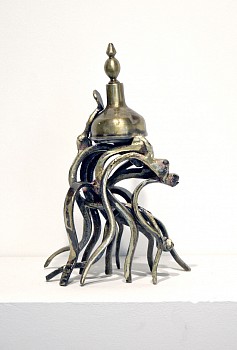Made in Makkah ®
A group exhibition of three Saudi artists from the holy city of Makkah. Curated by Raneem Farsi and Aya Alireza. In collaboration with Athr Gallery.
Nasser Al-Salem
Noha Al-Sharif
Saddek Wasil
Visual language has always been a strong expression of different cultural outlooks and worldviews. Art has often offered us a window into that ‘other’ way of looking. This exhibition explores not just how artists from the small town of Makkah view the world, but how their art is an expression of a much more universal paradigm.
The West-coined term of “Islamic art” is deemed by academics to have ended in the 19th century. All art produced post this period is not considered Islamic. However the main aspect that characterized Islamic art was that it was devotional, for ‘God is beautiful and loves beauty’. This was the unifying factor of all the art that was being produced across the massive expanse of the Islamic world. Therefore, the work of these three artists demonstrates that although the aesthetic of Islamic art has changed and modernized to a conceptual form, its spirit is not dead, for their art remains an act of devotion. The visual aesthetic of these artists incorporate the ethics of Truth, that God is One and is at the centre of everything.
Makkah Al-Mukarramah (Mecca the Honoured) has its roots in its pre-Islamic identity as a spiritual centre and pilgrimage destination. There is a cosmic orientation toward it as all Muslim’s turn to the direction of Makkah in prayer, at all times of the day, from all four corners of the globe. Millions of people from different racial backgrounds flock to it for Hajj every year, many of whom chose to settle, creating a melting pot of different cultures. Made in Makkah ® demonstrates how being born and raised in this spiritual magnet has shaped the artists’ cultural mentality and their faith.
Nasser Al-Salem’s works God is Alive and Shall Not Die and Kul are explorations of the infinite, and humanity’s incapacity to conceive it. His work is the embodiment of his human failure to comprehend but at the same time of his success in the attempt, for the work is a reminder of the omnipresence and omnipotence of the creator, an act of dhikr (remembrance). Al-Salem is a calligrapher to the core in his expression of the written word, but rather that traditionally focusing on the beauty of depiction, the concept of the word is Al-Salem’s focal point.
Noha Al-Sharif’s creates figurines of groups of women conducting the Islamic prayer ritual. Sculpted from marble and resin, the figurines create an overwhelming aura of peace, focus and cohesion. The work is a small manifestation of the power of group prayer, which Islam encourages as having greater spiritual benefits. In attempting to express the power of prayer, Al-Sharif’s work positions God at the centre of the universe, and thus can be considered an act of devotion, or a prayer in itself.
Saddek Wasil’s metallic sculptural works recognise the essence and the diversity of Makkah, through his particular focus on humans and the human emotions of all those who visit the holy city to be closer to God. He is a witness to their daily struggles as well as their innermost struggles at the moment when they are at their most transparent, before God. His work is in no way judgemental, but rather about understanding, acceptance, tolerance and the acknowledgement of seen and unseen realities.
Made in Makkah ® succeeds in opening a window into the mentality of a condensed microcosm of the Islamic world, one that is closed off from all non-Muslims. However, one begins to recognise that the message of these largely isolated artists is far from microcosmic and much more universal, that the works in their conceptual beauty, connect with the spirit and the age-old human instinct to believe in something greater than oneself.





